 (21 February 2017) Despite all the chaos and controversy of the first month of the Trump presidency, the
larger US economic picture is still basically positive. US stock
markets are trading at record highs as many investors are anticipating
the benefits of the administration's business-friendly agenda of tax
cuts, deregulation, and infrastructure. For now, the US economy
continues to chug along at the same modest growth rates that marked the
Obama administration but with signs that consumer spending may be on the
rise.
(21 February 2017) Despite all the chaos and controversy of the first month of the Trump presidency, the
larger US economic picture is still basically positive. US stock
markets are trading at record highs as many investors are anticipating
the benefits of the administration's business-friendly agenda of tax
cuts, deregulation, and infrastructure. For now, the US economy
continues to chug along at the same modest growth rates that marked the
Obama administration but with signs that consumer spending may be on the
rise. But the outlook still contains some uncertainty. Trump's border tax plan is problematic as it would increase the cost of imported goods and could thereby stoke inflation. Moreover, the plan is politically dubious and lacks clear support in Congress as members are wary of a possible trade war with its trading partners. Many economists wonder if Trump is more likely to enjoy the initial benefits of his populist "America First" policies for a year or two but then will have to face the negative consequences of his anti-globalization protectionist bias.
This uncertainty makes economic forecasting all the more valuable. Economists themselves do not have a good track record in forecasting, as the old joke tells us: "economists have correctly predicted nine out of the last five recessions." And neither do most astrologers for that matter. It's a complex area of human affairs that resists simple explanations no matter what paradigm one uses.
Previously, I discussed some of the possible impacts of Trumponomics making reference to the current Rahu dasha period in the USA chart and some of the major alignments this year. Both the two-year Saturn transit of sidereal Sagittarius and the extended Saturn-Rahu (North Lunar Node) aspect have the potential to depress sentiment and interfere with a growing economy in 2017 and beyond. I thought a recession was likely at some point in the first term without specifying exactly when.
The Sun-Jupiter conjunction cycle
This week I wanted to look at the economic outlook using another technique, namely the annual Sun-Jupiter conjunction. This is not a well-established method of interpretation. In fact, I do not recall seeing it elsewhere although the concept of it is obvious enough that it likely has been used somewhere. So it's more of a deductive experiment of mine that I believe has some decent evidence to support it. The premise is simple. The Sun moves into conjunction with Jupiter about once a year and has a 13-month, (i.e. 398-day) cycle. Jupiter is the planet of optimism, while the Sun plays its role as a neutral sort of time-keeper. Therefore, the Sun-Jupiter conjunction may provide information on the nature and quality of collective human optimism each year.
The resulting chart of each Sun-Jupiter conjunction can be judged according to standard astrological principles in terms of associated planets and aspects. If Sun-Jupiter is strengthened by the proximity of benefic planets like the Moon, Mercury, and Venus, then it is more likely that there will be greater amount of optimism. Since the economy and the stock market is driven by emotions and sentiment and Keynes famous "animal spirits", a greater amount of collective optimism should translate into more economic growth. When the Sun-Jupiter conjunction is aspected by malefics or otherwise poorly-placed, however, then optimism may be harder to come by and the economy is more prone to recession.
In future, I hope to compile a more thorough record of previous Sun-Jupiter conjunctions along with their correlations with the economy. For now, let's keep it brief by looking at a few recent Sun-Jupiter conjunctions that illustrate how this technique works. It makes comparative sense to pick a sequence of years where there was high growth which then faded into a recession. The Great Recession of 2007-2009 is the most recent case so we should examine the years leading up to the recession when growth was still robust.
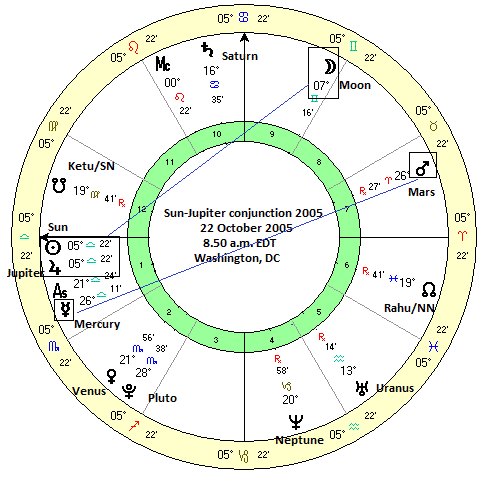
For the first Sun-Jupiter conjunction, I've chosen that of 22 October 2005 when the Sun conjoined Jupiter at 5 degrees of sidereal Libra. The economy grew at more than 3% real GDP and the stock market was also rising during this 13-month period so we should expect a fairly good chart. And we have one. The conjunction itself is rising in the 1st house (with the Ascendant) in Libra which is a plus. It also is unafflicted by malefics either by Vedic or Western aspecting rules. So that's also a positive point. And the Moon forms a nice 120 degree alignment with the conjunction so that adds to the overall optimism reflected in this chart. We can go further down the astrological rabbit hole if we want by noting the positive condition of the 11th house of gains as its sign ruler, the Sun (Leo), it with Jupiter in the 1st house. One sour note would be the very close opposition aspect between Mercury and Mars, however, I consider aspects involving other planets in the chart to be secondary in importance to the condition of the Sun-Jupiter conjunction itself.
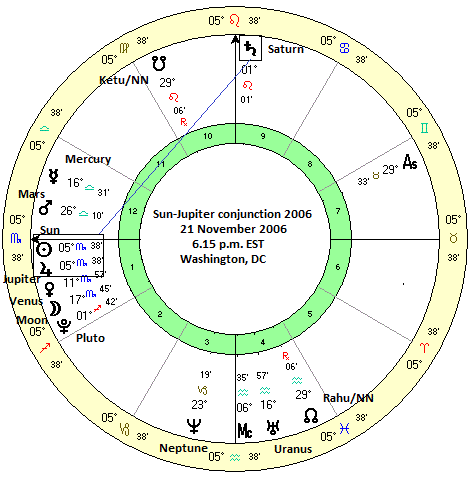
The next Sun-Jupiter conjunction occurred on 21 November 2006 at 5 degrees of Scorpio. The subsequent 13-month period also coincided with a period of fairly robust growth of almost 3% with attendant gains in the stock market. Growth was slowing a bit over the previous years but still fairly strong. The stock market peaked in October 2007 just a couple of months before the end of this Sun-Jupiter cycle. The chart looks good as benefics Moon and Venus both conjoin the Sun and Jupiter in Scorpio. Saturn squares Sun-Jupiter but this is the weaker forward square (90 degree) aspect of Saturn. It's a blemish to be sure, but in my view not enough to negate the positive effects of the Moon and Venus in the 1st house.
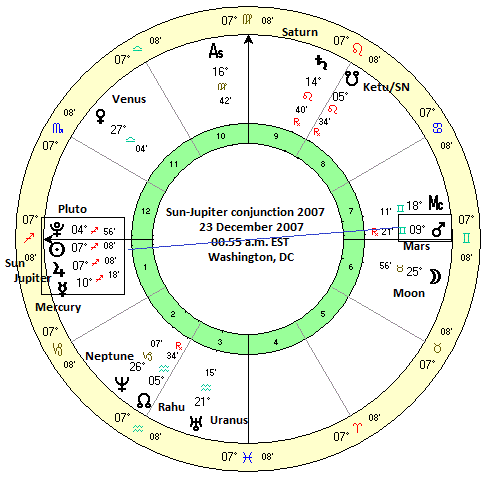
But the difference between those two charts and the next one is quite stark. The Sun next conjoined Jupiter on 23 December 2007. This was the Sun-Jupiter cycle that contained much of the meltdown as it was in effect until January 2009. Real GDP growth actually declined by 0.3% in 2008 while the stock market lost almost half its value. The recession hit will full force during this cycle. The chart is obviously terrible as the Sun-Jupiter conjunction is with Mercury and Pluto but all four are closely opposed by Mars. Mars is a bad planet, along with Saturn, and to variable extents, Rahu and Ketu. Additionally, Ketu aspected the Sun-Jupiter conjunction very closely and should be seen as one reason why the recession was much worse than a typical recession.
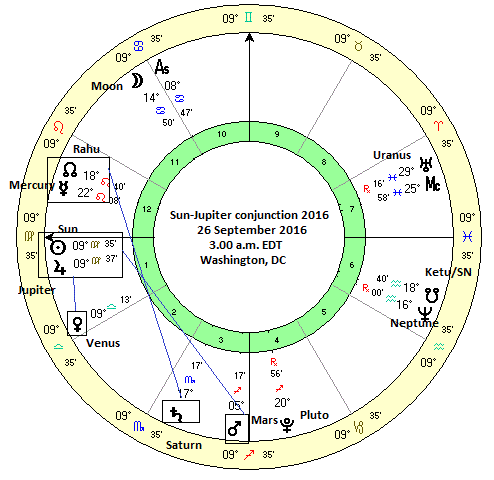
Now let's move forward to the present. What does the current Sun-Jupiter conjunction portend? The current Sun-Jupiter cycle began on 26 September 2016 and will run until 26 October 2017. The Sun conjoins Jupiter at 9 Virgo and is unafflicted by malefics. That's positive. The position of Venus also at 9 degrees of Libra in the 2nd house should be seen as supportive. More difficult is the square aspect involving Mars and Sun-Jupiter although this is a less than full strength backward square aspect. Also Saturn's square aspect to Lagnesh dispositor Mercury and Rahu in the 12th is a negative. But overall, the chart doesn't look too bad. It's not great but neither it is overly troubled. From this chart at least, I would think the US economy continues to muddle through with modest growth.
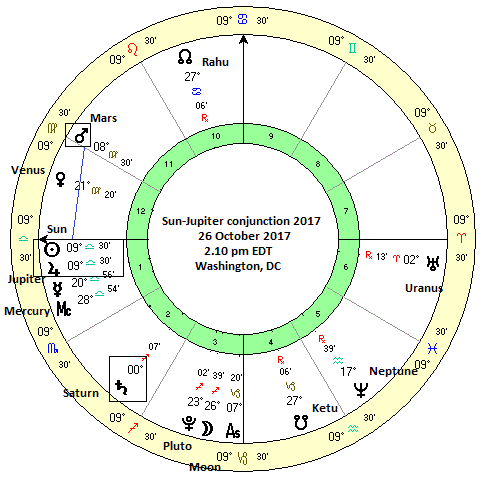
The next Sun-Jupiter cycle begins on 26 October 2017 as the conjunction occurs at 9 Libra. Again, Sun and Jupiter are unafflicted so that is a positive factor. The placement of dispositor Venus debilitated in Virgo in the 12th house is not good, and neither is the placement of Mars at 8 Virgo exactly on the equal 12th house cusp and in alignment with Sun-Jupiter. The fact that Saturn has just re-entered Sagittarius on that very day is a potentially worrisome sign as well. The chart looks weaker than the previous chart so we can make a case for a slowing US economy starting in late-2017 until late-2018. I would not say a recession is highly probable on this chart since the Sun-Jupiter conjunction itself still looks good. Nonetheless, there seems to be some risk of slowing growth.
A recession looks much more likely in 2019 and 2020 given the major afflictions in those Sun-Jupiter conjunction charts. Barring any new Trump-related developments this week, I will look into those and other relevant economic charts in more detail next week.
Weekly Market Forecast
Stocks have remained fairly buoyant last week and into early this week. We did see some modest declines towards the end of last week but as expected they did little to change the basically optimistic outlook of the market. The early week gains this week were also in keeping with the bullish influence of the Sun-Ketu conjunction. Stocks are being supported in part by the very close Jupiter-Uranus opposition aspect. This aspect has added strength due to the unusually slow velocity of Jupiter as it moves through its retrograde cycle. A slow Jupiter is a more bullish Jupiter.
This week is likely to produce more of the same. We could see a pullback on Wednesday or Thursday on the Mercury-Saturn aspect but like last week, it does not seem sufficiently negative to offset the up trend. The following week may prove to be a very different story, however, as Mars aligns with Jupiter and Uranus on the 26-27th, just a day after the solar eclipse. Volatility may rise on these patterns.
For more details and analysis on market trends for this week, this month and this year, please check out my weekly MVA Investor Newsletter. The newsletter is published every Saturday and includes extended discussion of US and Indian stock markets, as well as gold, oil and major currencies.